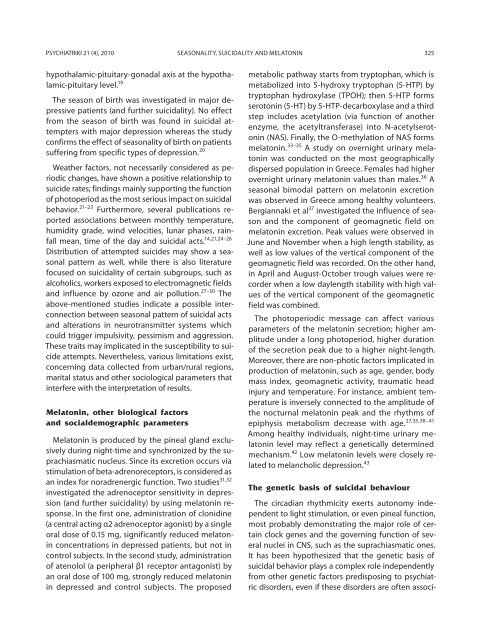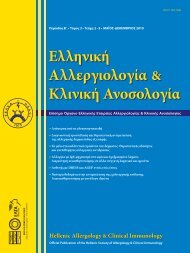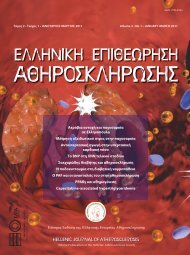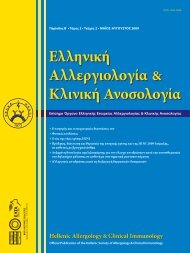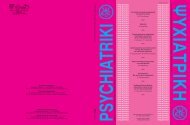ÏÏ ÏιαÏÏικη - ÎÎΤΠÎαÏÏικÎÏ ÎκδÏÏειÏ
ÏÏ ÏιαÏÏικη - ÎÎΤΠÎαÏÏικÎÏ ÎκδÏÏειÏ
ÏÏ ÏιαÏÏικη - ÎÎΤΠÎαÏÏικÎÏ ÎκδÏÏειÏ
- No tags were found...
You also want an ePaper? Increase the reach of your titles
YUMPU automatically turns print PDFs into web optimized ePapers that Google loves.
PSYCHIATRIKI 21 (4), 2010 SEASONALITY, SUICIDALITY AND MELATONIN 325hypothalamic-pituitary-gonadal axis at the hypothalamic-pituitarylevel. 19The season of birth was investigated in major depressivepatients (and further suicidality). No effectfrom the season of birth was found in suicidal attempterswith major depression whereas the studyconfirms the effect of seasonality of birth on patientssuffering from specific types of depression. 20Weather factors, not necessarily considered as periodicchanges, have shown a positive relationship tosuicide rates; findings mainly supporting the functionof photoperiod as the most serious impact on suicidalbehavior. 21–23 Furthermore, several publications reportedassociations between monthly temperature,humidity grade, wind velocities, lunar phases, rainfallmean, time of the day and suicidal acts. 14,21,24–26Distribution of attempted suicides may show a seasonalpattern as well, while there is also literaturefocused on suicidality of certain subgroups, such asalcoholics, workers exposed to electromagnetic fieldsand influence by ozone and air pollution. 27–30 Theabove-mentioned studies indicate a possible interconnectionbetween seasonal pattern of suicidal actsand alterations in neurotransmitter systems whichcould trigger impulsivity, pessimism and aggression.These traits may implicated in the susceptibility to suicideattempts. Nevertheless, various limitations exist,concerning data collected from urban/rural regions,marital status and other sociological parameters thatinterfere with the interpretation of results.Melatonin, other biological factorsand socialdemographic parametersMelatonin is produced by the pineal gland exclusivelyduring night-time and synchronized by the suprachiasmaticnucleus. Since its excretion occurs viastimulation of beta-adrenoreceptors, is considered asan index for noradrenergic function. Two studies 31,32investigated the adrenoceptor sensitivity in depression(and further suicidality) by using melatonin response.In the first one, administration of clonidine(a central acting α2 adrenoceptor agonist) by a singleoral dose of 0.15 mg, significantly reduced melatoninconcentrations in depressed patients, but not incontrol subjects. In the second study, administrationof atenolol (a peripheral β1 receptor antagonist) byan oral dose of 100 mg, strongly reduced melatoninin depressed and control subjects. The proposedmetabolic pathway starts from tryptophan, which ismetabolized into 5-hydroxy tryptophan (5-HTP) bytryptophan hydroxylase (TPOH); then 5-HTP formsserotonin (5-HT) by 5-HTP-decarboxylase and a thirdstep includes acetylation (via function of anotherenzyme, the acetyltransferase) into N-acetylserotonin(NAS). Finally, the O-methylation of NAS formsmelatonin. 33–35 A study on overnight urinary melatoninwas conducted on the most geographicallydispersed population in Greece. Females had higherovernight urinary melatonin values than males. 36 Aseasonal bimodal pattern on melatonin excretionwas observed in Greece among healthy volunteers.Bergiannaki et al 37 investigated the influence of seasonand the component of geomagnetic field onmelatonin excretion. Peak values were observed inJune and November when a high length stability, aswell as low values of the vertical component of thegeomagnetic field was recorded. On the other hand,in April and August-October trough values were recorderwhen a low daylength stability with high valuesof the vertical component of the geomagneticfield was combined.The photoperiodic message can affect variousparameters of the melatonin secretion; higher amplitudeunder a long photoperiod, higher durationof the secretion peak due to a higher night-length.Moreover, there are non-photic factors implicated inproduction of melatonin, such as age, gender, bodymass index, geomagnetic activity, traumatic headinjury and temperature. For instance, ambient temperatureis inversely connected to the amplitude ofthe nocturnal melatonin peak and the rhythms ofepiphysis metabolism decrease with age. 27,35,38–41Among healthy individuals, night-time urinary melatoninlevel may reflect a genetically determinedmechanism. 42 Low melatonin levels were closely relatedto melancholic depression. 43The genetic basis of suicidal behaviourThe circadian rhythmicity exerts autonomy independentto light stimulation, or even pineal function,most probably demonstrating the major role of certainclock genes and the governing function of severalnuclei in CNS, such as the suprachiasmatic ones.It has been hypothesized that the genetic basis ofsuicidal behavior plays a complex role independentlyfrom other genetic factors predisposing to psychiatricdisorders, even if these disorders are often associ-


